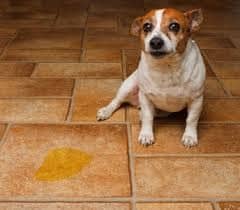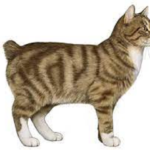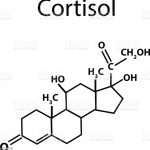
When an older house trained house pet begins urinating inappropriately, many owner confuse this and call it urinary incontinence.
Differentiating incontinence from other issues is important as the different causes have very different treatments. Incontinence occurs when, often due to age or female dogs spayed young, when a weak bladder sphincter is present. Often this type of inappropriate urination is noted when the pet changes position from laying down to standing up.
Other Causes Of Inappropriate Urination
It is important to differentiate incontinence (involuntary urine leakage) from other urinary issues such as submissive urination – often seen in dogs – simple lack of housetraining, territorial marking of anxious cats or of un-neutered males, or the senile loss of house-training from canine cognitive dysfunction.
Other causes are urinary tract infects, bladder stones or crystals, bladder inflammation, diseases such as diabetes, kidney failure, badder tumors and more.
Watch your pet closely to be sure what you are seeing is really incontinence and if it is, the good news is that most cases are easily resolved with simple inexpensive medications.
There are several important causes of incontinence and most of these are ruled in or out with a urinalysis and urine culture. The urinalysis reveals cell types and biochemical elements in the patient’s urine while the culture isolates the bacteria growing in the urine. The bacterial species grown are identified and tested for their sensitivity towards different antibiotics, the end result being confirmation of the presence of infection and a list of appropriate antibiotics.
Most cases of incontinence are due to:
- Infection of the urinary tract (usually bladder infection)
- Excessive consumption of water
- Spinal cord disease
- Endocrine disease such as diabetes
- In facts, stress and the need for more hydration can cause issues leading to bladder inflammation called cystitis
Bladder Infection
This is a common cause of urinary incontinence in female dogs of all ages and in geriatric cats. This condition is usually easily diagnosed by urine culture, though often signs of infection such as white blood cells or bacteria are actually visible in the urinalysis. A urine culture will confirm the infection, identify the organism, and list usually several antibiotics which will be effective. An antibiotic is selected based on expense, potential for side effects, and convenience of usage.
If a bladder infection is the cause of incontinence, most patients show improvement in their inappropriate urination after 24 hours antibiotics (but it is still important to finish the entire course so as to avoid recurrence).
Diseases that cause excessive drinking of water
Some animals drink so much water that their bladders simply overflow too easily. While some owners have noticed that their pets seem to be drinking more than usual, our experience is that most owners are surprised when the urinalysis shows excessive water consumption.
Dilute urine is obvious on the urinalysis through a measurement called specific gravity that compares the amount of dissolved biochemicals in the urine to that of pure water (which has no dissolved biochemicals). A urine specific gravity nearly the same as water, confirms excessive water consumption; blood tests may be indicated to go with the urine tests to determine the cause.
Causes of excessive water consumption include:
- Diabetes mellitus or insipidus
- Cushing’s syndrome
- Hyperthyroidism (cats)
- Bladder infection or UTI (see above)
- Kidney failure
There are other causes as well but 90% are ruled in or out by a blood panel and urine culture.
Weak Bladder Sphincter
Aging, obesity, reduced sensitivity of neurologic receptors in the sphincter and possibly other factors all contribute to this condition which is especially common (up to one in five affected) in female dogs. Once other more serious conditions have been ruled out, the weak sphincter may be treated symptomatically with one of several medications.
Estrogens
There are estrogen receptors on the bladder. Estrogen may influence the development of these receptors and/or their responsiveness to estrogen. So female dogs that are spayed early, may have bladders that require estrogen to help with sphincter control.
In dogs, diethylstilbestrol (DES) has traditionally been the most common estrogen used to help regain bladder control in a young female dog that has urinary incontinence. Other estrogens that have been used include estriol (Incurin®) and conjugated estrogens such as Premarin®. Regardless of which product is used, the basic process is the same. A higher dose is utilized to begin therapy and, if it is effective, the dose is tapered to the lowest dose needed to maintain effect.
In male dogs, testosterones seem to be more effective than estrogens (also extra testosterone is converted into estrogen) possibly through action on the prostate which sits at the neck of the bladder and incorporates the sphincter.
Alpha-Adrenergic Agonists
Other medications that are often used in older pets with weakened sphincters act by enhancing release of the neurotransmitter chemicals that strengthen the bladder sphincter. The most common medication for canine use is phenylpropanolamine, currently available in liquid and chewable tablets and is typically given two or three times daily. The brand name is Proin.
Ephedrine and pseudoephedrine, common decongestants, are sometimes recommended alternatively. Side effects can include irritability, appetite suppression (phenylpropanolamine was the active ingredient in many human diet pills until recently), and blood pressure changes. Most dogs, male and female alike, tolerate phenylpropanolamine well. For especially resistant cases of incontinence, estrogens and alpha-adrenergic agonists can be used together.
There are other medications that can be used. Your veterinarian can help diagnose the underlying cause and work with you and your pet to find the best therapy
Surgical Therapy
Medication works for most patients with weak sphincters but when medication fails there are some surgical options to consider: colposuspension and cystourethropexy – very big words!
Colposuspension, for females only, is the most commonly performed procedure. Here, the vagina is tacked to the bottom of the belly wall entrapping and compressing the urethra. In one study of dogs that had failed on medication, there was complete resolution of incontinence in 53% with colposuspension. An additional 37% became less incontinent and 25% of those without full resolution gained complete continence when therapy with phenylpropanolamine was added. Another recent study reported that complete continence lasted for 1 year in only 14% of affected dogs, although many dogs improved.
Cystourethropexy is the modification of the above procedure that can be performed in either males or females. Since there is no vagina to use in the male, the ductus deferens are tacked down to compress the urethra. Fibers from the urethral muscles can also be tacked down (in either male or female patients). Complications include an increased frequency in the need to urinate (occurring in 2/3 of the patients in one study) and straining to urinate (in about 1/3 of patients).
Urethral lengthening works for patients for whom incontinence is caused by a short urethra. A short urethra causes a full bladder to be displaced into the pelvis and makes the urethra too short for either of the other two surgical procedures. This is a newer surgical procedure that so far has had good reports in the small number of dogs in which it has been studied. Further studies should be forthcoming.
Medications listed above are used in conjunction with surgery. Surgery alone improves approximately 50% of patients but often incontinence returns unless oral medication is restarted.
Collagen Injections: The Newest Therapy
In this procedure an endoscope is inserted in the urethra and several injections of collagen (the same kind used for cosmetic injections in humans) are deposited. In a study of 40 dogs who had failed to become continent on medication alone, 27 became continent for an average of 17 months. Furthermore, 10 dogs that experienced only partial improvement after the procedure became completely continent when oral medication was added, even though medication alone had been ineffective.
The procedure can alternatively be performed with medical grade collagen, with Teflon® (which does not last as well but is apparently considerably less costly) or with a reconstructive product called ACell®. Unfortunately, at this time there are few facilities that perform this procedure as special equipment (cystoscopy) is required.
Unusual Causes Of Incontinence
The list of causes of incontinence presented above is by no means exhaustive. While uncommon, other causes should not be entirely counted out. Some possible causes include:
- Ectopic ureter (instead of connecting to the urinary bladder, the ureter transporting urine from the kidney connects to the vagina or rectum so that there is no storage of urine. This condition is typically noted in a puppy that simply cannot be housebroken and leaks urine. The condition can be solved surgically.)
- Spinal damage especially in the lower lumbar area. Spinal surgery may be indicated to decompress an area of nerve pressure that is interfering with the nerves of urination control.
Your veterinarian is in the best position to determine if it is worthwhile to pursue a rare disease or not. Do not hesitate to ask your veterinarian questions regarding your pet’s incontinence, the treatments or procedures described above.


